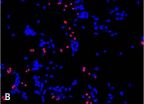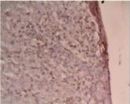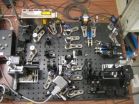(Press-News.org) LOS ANGELES (March 11, 2014) – Researchers in the Cedars-Sinai Samuel Oschin Comprehensive Cancer Institute eradicated solid tumors in laboratory mice using a novel combination of two targeted agents. These two synergistic therapies stimulate an immune response, ultimately allowing solid tumors to act as their own cancer-fighting vaccine.
The study's findings, published in the journal Cancer Research, are the first to use these combined agents as an immune stimulator and may have the potential to kill cancerous cells in solid tumors, including some of the most aggressive cancers that form in the lung and pancreas. Investigators hope to bring this science to early-phase clinical trials in coming months.
"Instead of administering a cancer vaccine to destroy tumors, we hope to modify the immune system to allow the patient's own tumor to act as a cancer vaccine," said Hyung Lae Kim, MD, co-medical director of the Urologic Oncology Program and lead author of the study. "This approach differs from traditional methods, where the immune system is stimulated by administering a vaccine. Instead, we administer a combination therapy to allow immune cells, which are capable of killing tumors, to see tumors that were previously invisible to the immune system."
When an immune system is working properly, diseased cells are captured and killed. However, cancerous tumors are formed when the immune system is unable to remove these diseased cells. Using an "mTOR inhibitor," which regulates cellular metabolism, and a CD4 antibody, which helps to initiate an immune response, researchers increased the immune system's "memory" and ability to recognize and fight off tumors.
"With our approach, investigators simply combine an mTOR inhibitor and CD4 antibody to create an immunotherapy treatment, requiring no surgery and a drug with virtually no shelf life," said Robert Figlin, MD, deputy director of the Samuel Oschin Comprehensive Cancer Institute and the Steven Spielberg Family Chair in Hematology-Oncology. "This broad implication is in contrast to a more traditional vaccine-based approach, which requires a specialist to surgically remove tumor samples from a patient's body then create a personalized vaccine approach for one specific patient."
The combination of a CD4 antibody with an mTOR inhibitor may enhance immune memory and eradicate solid tumors. Additional research is being done to better understand how the drugs work and develop optimal strategies for applications in patients.
INFORMATION:
Yanping Wang, MD, project coordinator in the Kim Laboratory at Cedars-Sinai, and Tim Sparwasser, MD, from the Institute of Infection Immunology at TWINCORE, were involved in the study.
Citation: Cancer Research. 2014 February: Foxp3+ T cells inhibit antitumor immune memory modulated by mTOR inhibition.
The immune system's redesigned role in fighting cancerous tumors
A novel combination of 2 agents eradicates solid tumors in preclinical studies
2014-03-12
ELSE PRESS RELEASES FROM THIS DATE:
Fruit flies help uncover tumor-preventing protein complex
2014-03-12
A team of researchers from Duke-NUS Graduate Medical School have discovered a protein complex that disrupts the process known as dedifferentiation (1), known to promote tumor development.
Dedifferentiation (reversion) is a process that leads progenitor (2) or mature cells to become 'ectopic neural stem cells' which causes tumors. By detecting this protein complex, Duke-NUS researchers have shed light on a process that inhibits tumor development and gives hope for the discovery of therapies and treatments that target tumor prevention through this pathway.
Researchers ...
Researchers slow pancreatic cancer growth by blocking key enzyme
2014-03-12
A research team from Imperial College London has shown that blocking the function of an enzyme known as Hhat slows the growth and spread of pancreatic cancer, by preventing a protein called Hedgehog from stimulating nearby normal cells to help the cancer.
The study, funded by the UK research charity Pancreatic Cancer Research Fund, examined the role of Hedgehog, whose usual job is to send signals to cells in embryos to divide and grow into the correct body parts. But while Hedgehog usually switches off when the embryo is formed, in many cancers, including pancreatic, ...
Superior visual thinking may be key to independence for high schoolers with autism
2014-03-12
Researchers at UNC's Frank Porter Graham Child Development Institute (FPG) and UNC's School of Education report that teaching independence to adolescents with autism can provide a crucial boost to their chances for success after high school.
"We explored many factors that contribute to the poor outcomes people with autism often experience," said Kara Hume, co-principal investigator of FPG's Center on Secondary Education for Students with Autism Spectrum Disorders (CSESA). "It's clear that teaching independence to students with autism should be a central focus of their ...
Chronic pain research explores the brain
2014-03-12
New insights into how the human brain responds to chronic pain could eventually lead to improved treatments for patients, according to University of Adelaide researchers.
Neuroplasticity is the term used to describe the brain's ability to change structurally and functionally with experience and use.
"Neuroplasticity underlies our learning and memory, making it vital during early childhood development and important for continuous learning throughout life," says Dr Ann-Maree Vallence, a Postdoctoral Fellow in the University of Adelaide's Robinson Institute.
"The mechanisms ...
Surface characteristics influence cellular growth on semiconductor material
2014-03-12
Changing the texture and surface characteristics of a semiconductor material at the nanoscale can influence the way that neural cells grow on the material.
The finding stems from a study performed by researchers at North Carolina State University, the University of North Carolina at Chapel Hill and Purdue University, and may have utility for developing future neural implants.
"We wanted to know how a material's texture and structure can influence cell adhesion and differentiation," says Lauren Bain, lead author of a paper describing the work and a Ph.D. student in ...
Alpha-synuclein effects on dopaminergic neurons: Protection or damage?
2014-03-12
Alpha-synuclein is a principal component of Lewy bodies and Lewy neurites, which are pathologic hall-marks of Parkinson's disease. Alpha-synuclein is generally considered to play a role in synaptic activity, although its function remains largely unknown. Accumulative evidence has been shown that aggregated extracellular alpha-synuclein fibrils can be internalized in the cells and enhance the intracellular formation of protein inclusions, leading to cell death. Conversely, there is emerging evidence suggesting that alpha-synuclein has also neuroprotective effects. In one ...
PD-L1: A potential treatment target for multiple sclerosis
2014-03-12
Experimental allergic encephalomyelitis is a mouse model of human multiple sclerosis with similar pathology and pathogenesis. Th1 cells play an important role in the pathogenesis of experimental allergic encephalomyelitis. Therefore, Qun Xue, Fanli Dong and co-workers from the First Affiliated Hospital of Soochow University in China speculated that programmed cell death 1 ligand 1 (PD-L1) plays an important role in the pathogenesis of multiple sclerosis. A recent study by these researchers published in the Neural Regeneration Research (Vol. 8, No. 35, 2013) found that the ...
Quantum physics secures new cryptography scheme
2014-03-12
The way we secure digital transactions could soon change. An international team has demonstrated a form of quantum cryptography that can protect people doing business with others they may not know or trust – a situation encountered often on the internet and in everyday life, for example at a bank's ATM.
"Having quantum cryptography to hand is a realistic prospect, I think. I expect that quantum technologies will gradually become integrated with existing devices such as smartphones, allowing us to do things like identify ourselves securely or generate encryption keys," ...
Peripheral nerve regeneration using a nerve growth factor-containing fibrin glue membrane
2014-03-12
Complete regeneration is usually very difficult following peripheral nerve damage, though microsurgical techniques have vastly increased the success rate of surgery to repair the injured nerve. This occurs possibly because of a lack of neurotrophic factors and extracellular matrix in the injured region, which results in a microenvironment that is not optimal for peripheral nerve regeneration. Nerve growth factor (NGF) was the first neurotrophic factor identified in a class of molecules responsible for neuronal survival and differentiation. Consequently, many techniques, ...
Iron overload is a risk factor for diabetic peripheral neuropathy
2014-03-12
Iron overload can lead to cytotoxicity, and it is a risk factor for diabetic peripheral neuropathy. However, the underlying mechanism remains unclear. Prof. Shi Zhao and team conjectured that iron overload-induced neurotoxicity might be associated with oxidative stress and the NF-E2-related factor 2 (Nrf2)/ARE signaling pathway. As an in vitro cellular model of diabetic peripheral neuropathy, PC12 cells exposed to high glucose concentration were used in this study. PC12 cells were cultured with ferric ammonium citrate at different concentrations to create iron overload. ...
LAST 30 PRESS RELEASES:
Chicago health information leader recognized for raising CPR readiness and blood pressure awareness
The Intimate Animal, a new book from Kinsey Institute Executive Director Dr. Justin Garcia
When blue-collar workers lose union protection, they try self-employment
New video dataset to advance AI for health care
MEA-based graph deviation network for early autism syndrome signatures in human forebrain organoids
New modeling approach sheds light on rare gut disease
Study documents potentially hazardous flame retardants in firefighter gear
Can certain bacteria regulate aging of the immune system and its related alterations?
AI model helps diagnose often undetected heart disease from simple EKG
There are fewer online trolls than people think
Cell membrane fluctuations produce electricity
Jeonbuk National University study shows positive parenting can protect adolescents against self-harm
Surface-engineered ZnO nanocrystals to tackle perfluoroalkyl substance contamination
This new understanding of T cell receptors may improve cancer immunotherapies
A new fossil face sheds light on early migrations of ancient human ancestor
A new immunotherapy approach could work for many types of cancer
A new way to diagnose deadly lung infections and save lives
40 percent of MRI signals do not correspond to actual brain activity
How brain-inspired algorithms could drive down AI energy costs
Gum disease may be linked to plaque buildup in arteries, higher risk of major CVD events
Contrails are a major driver of aviation’s climate impact
Structure of dopamine-releasing neurons relates to the type of circuits they form for smell-processing
Reducing social isolation protects the brain in later life
Keeping the heart healthy increases longevity even after cancer
Young adults commonly mix cannabis with nicotine and tobacco
Comprehensive review illuminates tau protein's dual nature in brain health, disease, and emerging psychiatric connections
Book prepares K-12 leaders for the next public health crisis
Storms in the Southern Ocean mitigates global warming
Seals on the move: Research reveals key data for offshore development and international ecology
Sports injuries sustained during your period might be more severe
[Press-News.org] The immune system's redesigned role in fighting cancerous tumorsA novel combination of 2 agents eradicates solid tumors in preclinical studies





